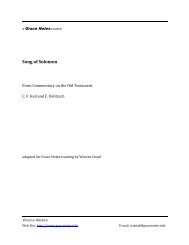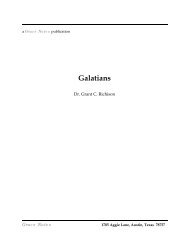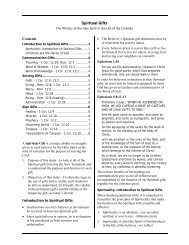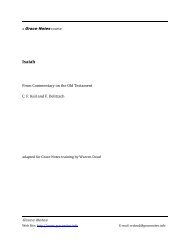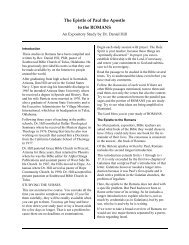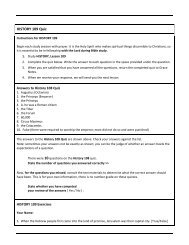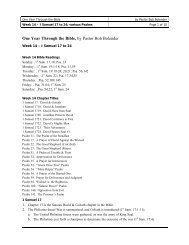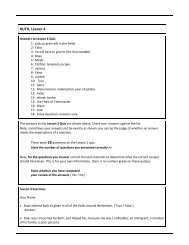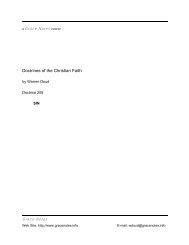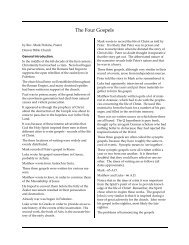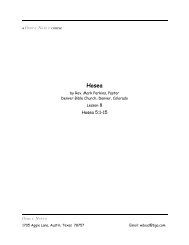Create successful ePaper yourself
Turn your PDF publications into a flip-book with our unique Google optimized e-Paper software.
<strong>Apostolic</strong> <strong>Fathers</strong> 6to love each other and give alms, and to shunidolatry, murder, lies, and witchcraft. Nothingcould be assumed. <strong>The</strong>re is some evidence that“Barnabas” is at times alluding to this moralcatechism even in the earlier parts of his epistle(e.g., 1:4; 2:9; 4:1, 10; 5:4), and chs 18–21 givethe impression that the author (or someoneelse) has simply appended the full text of hissource for the sake of completeness. Certainlythe Latin tradition witnesses to the fact thatBarnabas circulated without this material aswell as with it. But in any case the author orfinal editor has attached a summary whichdraws together chs 1–17 and 18–20 and servesas the conclusion to both (ch 21). <strong>The</strong> very firstverse of this concluding statement makes itclear that “Barnabas” has made use of theprimitive “Two Ways” material in written form(21:1). Like the NT writers, the author knowsthat his readers are never too mature to bereminded of what they have been taught atconversion.IV. Didache<strong>The</strong> longer title of this work, “<strong>The</strong> Teaching ofthe Lord, through the Twelve Apostles, to theGentitles,” gives a clue to its nature. It seems tobe a work conceived against the background ofMt. 28:18–20, purporting to give the content ofthat which the twelve apostles taught to the“Gentiles” or “nations” of the things which Jesusthe Lord had commanded. It therefore stands ina tradition somewhat different from the onewhich sees Paul as the apostle to the Gentilespar excellence and the Twelve as missionariesto the Jews (cf., e.g., Gal. 2:9); instead theTwelve, representing the whole Church, aresent to the whole world, and indeed especiallyto the Gentiles. Shorter variations of this title(e.g., Teaching [or Teachings] of the Apostles)are cited by several patristic writers (e.g.,EusebiusHE iii.25.4; Athanasius Festal Letter39; the ninth-century Stichometry ofNicephorus), but there is no way to be sure thatthey are identical to the work now known bythis name.This work really came to light for the first timein the Constantinople MS discovered byBryennios. As a result of the publication of thefull text of the Didache in 1883, the “canon” ofthe <strong>Apostolic</strong> <strong>Fathers</strong> was enlarged by one. Itthen became possible to go back and see thatthe Didache in Greek was actually to be found(in a somewhat revised form) in book vii of thefourth-century Egyptian <strong>Apostolic</strong>Constitutions. In addition there are fragmentsin Greek (Oxyrhynchus Papyrus 1782), Coptic,and Ethiopic, and a complete Georgian version.For the “Two Ways” section there is (besidesthe witness of Barn 18–20) a Latin version (theDoctrina) the fourth-century <strong>Apostolic</strong> ChurchOrder, and three other manuals of the 4th centor later. <strong>The</strong>re is no way of being sure that theConstantinople MS represents the “original”Didache nor even what the term “original”exactly means in such a context. We are notdealing here simply with textual variants as wedo when studying the NT, but with a developingtradition, and our various witnesses to theDidache merely afford us glimpses of thistradition at various stages. Total agreement isseldom possible as to which forms are primitiveand which are later adaptations. <strong>The</strong>refore it isdifficult to speak about dates, but thecompilation of purportedly apostolic materialunder the name of the apostles as a groupindicates that the apostles are already figures ofthe past. This together with the apparent use ofMatthew’s Gospel tends to suggest a date ofcomposition in the 2nd cent, though manyspecific elements (e.g., the prayers, the “TwoWays,” and the eschatological teaching) maywell go back to the apostolic age and evenperhaps to the early days of the Jerusalemchurch.<strong>The</strong> “Two Ways” section of the Didache comesat the beginning (1:1–6:2) rather than at theend as in Barnabas. <strong>The</strong> “way of life” is found in1:2–4:14 and the “way of death” in 5:1f, with abrief summary in 6:1–3. <strong>The</strong> parallels withBarnabas are rather close, though by no meansverbal. Didache contains an interpolation in its“Two Ways” material, consisting of words ofJesus based on Matthew and Luke and/or anunknown collection of traditional sayings(1:3b–2:1). This section is missing from the“Two Ways” both in Barnabas and in theDoctrina. It has been inserted here as the“teaching” or explanation of the negative formof the Golden Rule found in 1:2. Thus 2:2–7(which does belong to the “Two Ways”)



